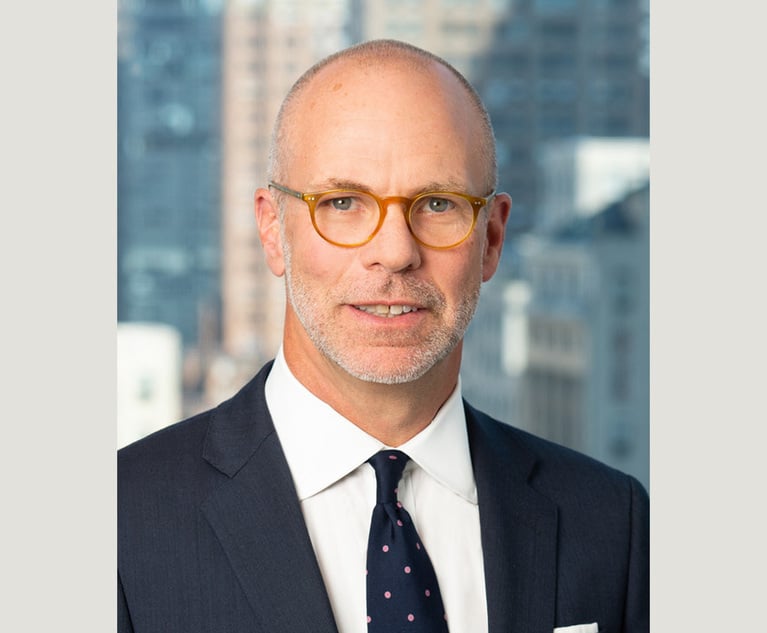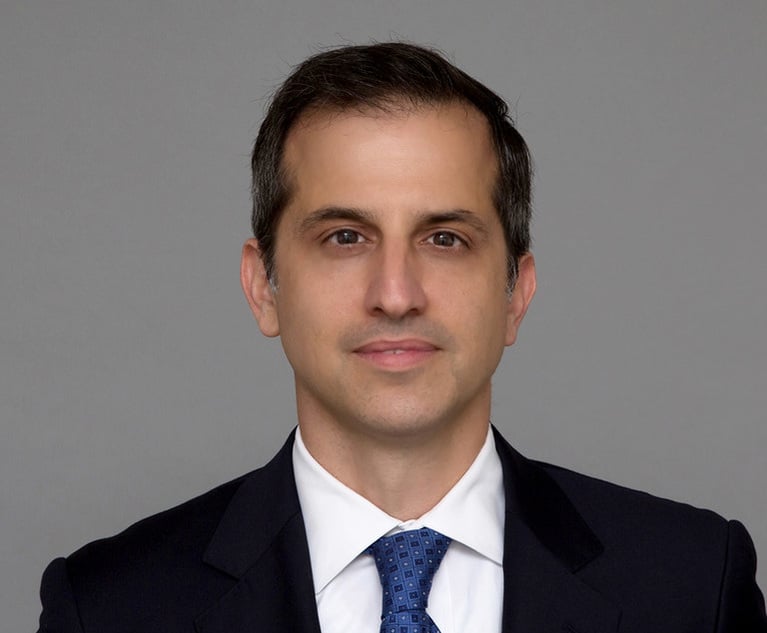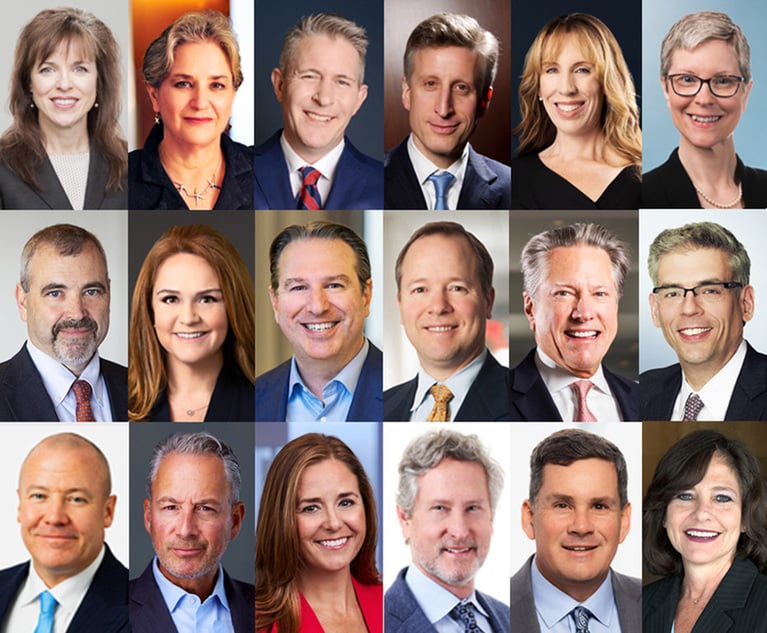 Richard Krumholz, US Head of Dispute Resolution and Litigation at Norton Rose Fulbright (Photo: Courtesy Photo)
Richard Krumholz, US Head of Dispute Resolution and Litigation at Norton Rose Fulbright (Photo: Courtesy Photo)Litigation Leaders: Norton Rose Fulbright's Richard Krumholz on Building a Diverse Team and Playing Offense for Clients
"We analyze cases in the first 60 to 90 days and deliver a strategy and budget tailored to the client. What also sets us apart is that we play offense while other large firms typically are reactive or play defense."
July 20, 2020 at 07:30 AM
12 minute read
Welcome to another edition of our Litigation Leaders series, featuring the litigation practice leaders of the biggest firms in the country.
Meet Richard Krumholz, the head of dispute resolution and litigation in the United States for Norton Rose Fulbright. Based in Dallas, his practice encompasses a broad range of matters including securities and merger litigation, multi-jurisdictional qui tam cases, bankruptcy adversary proceedings, energy litigation, and multidistrict litigation.
Lit Daily: Tell us a little about yourself—beyond what's in your law firm bio.
Richard Krumholz: I grew up in Austin in the '70s and '80s back when it was a small town. For those who know the city, this was even before Missouri Pacific (MoPac) freeway was contemplated. My best friends and I spent most summers outside, playing sports or fishing. Like many my age, we played every sport depending on the season, and we rode bikes everywhere.
After high school, I went to the University of Texas, Austin, staying close to home but rarely going home. It was there I met who would become my closest friends in life and many career-long clients. These friends were from all over Texas and the country—New York, Memphis, Tuscaloosa, Atlanta and California. These friendships have lasted a lifetime. They will always be the relationships I can count on the most in difficult times, and they are the people with whom I celebrate successes in life.
After law school, I soon learned that I chose the right profession and was hired by Fulbright & Jaworski, long known to be a litigation powerhouse. Thanks to our firm's rich tradition and training, I quickly tried cases and was fortunate to first-chair trials and second-chair others with legends in our firm—the likes of Frank Jones and John Weber. When I look back, honing those skills over the last 30 or so years has been one of the most rewarding aspects of my career. The last three decades have also taught me the importance of collegiality and collaboration. I consider our firm to be a second family, and I will always cherish the relationships I have built here.
How big is your litigation department and where are most of your litigators concentrated geographically?
We have one of the largest disputes practices in the world with more than 1,200 lawyers. We are proud to boast a deep bench of nearly 350 trial lawyers across our 11 US offices, accounting for more than 40% of our domestic lawyer count. Most of our US litigation lawyers are based in Texas, where we have a more than 100-year history. Our firm has always had a special relationship with Texas and, following our successful combination with Chadbourne & Parke three years ago, we have strengthened our presence on the East Coast—we now have more than 100 litigators based in New York and Washington, DC.
In what three areas of litigation do you have the deepest bench? (I know it's tempting to list more, but please just name three.)
It is tough narrowing this down to just three, but our deepest litigation practice areas are commercial litigation, white-collar defense/securities litigation and mass tort/multi-district litigation. These teams comprise more than 160 lawyers—roughly half of our U.S. disputes group—and they are highly equipped to handle cases across a wide array of sub-practices and industries, including banking and finance, energy, healthcare, data privacy and cybersecurity, government and technology. Our commercial litigation group is a powerhouse led by Tom McCormack in New York and Scott Incerto in Austin, boasting 75 trial lawyers nationwide. Kevin Harnisch in Washington, D.C., and Gerry Pecht in Houston lead our highly versatile white-collar and securities litigation team.
Our mass tort team, which also includes pharmaceutical/medical device MDL litigation, is led by Steve Jansma in San Antonio. This team, featuring more than 40 lawyers across the country, is routinely called upon by some of the world's largest companies to defend them in some of the most difficult jurisdictions. I would add that our international arbitration, energy, environmental, financial restructuring and labor employment practices are routinely ranked as tops in their fields.
As head of the department, what are some of your goals or priorities?
My biggest goal is to support our partners in their efforts to develop and expand their practices. I view our partners as my clients, and one of my proudest accomplishments has been to help build upon our elite group of partners by helping the next generation. This is a group of 40-to-50-year old partners who are not only valued by our clients but are now known as the very best in their fields.
We must also continue to: (1) add tremendous legal talent to our strong litigation team; and (2) further strengthen our team's culture, ensuring collaboration, improving information flow and ensuring that our disputes lawyers have all the tools to do their very best. Our continued success is built upon a culture that inspires greatness. Along with the rest of our great U.. leadership team, I am committed to protecting and enhancing our strong connection to each other and our profession.
Most importantly, we must push to be a more diverse team and law firm overall. We certainly value diversity and our clients expect it; including diverse individuals and perspectives is critical to our continued success. In our litigation group, our most successful partners are diverse—a fact that sets us apart and for which we should be proud. Through our lateral hires, we look to build a more diverse organization that is reflective of our clients, personnel and the communities in which we live. This consistent focus continues to enhance our firm and its culture.
What do you see as hallmarks of your firm's litigators? What makes you different?
For more than 100 years, we have handled and tried some of the most difficult cases in the most dangerous jurisdictions. Litigation is in our DNA. We have one of (if not) the largest and deepest trial groups in the world. I say this not to boast but to emphasize that this is what we do best. We are well-recognized adversaries around the country, known for our creative thinking and aggressive approach. And our focus has always been on how our clients define success—often requiring a nuanced approach to all of the issues faced. Our clients' business objectives drive every strategy decision, including the staffing, budgeting and public relations efforts needed in each matter.
We analyze cases in the first 60 to 90 days and deliver a strategy and budget tailored to the client. What also sets us apart is that we play offense while other large firms typically are reactive or play defense. We fully understand that clients rarely want to go to trial but, when they are necessary, we have some of the best trial lawyers in the country—and they routinely obtain exceptional results at the courthouse. I say this not because clients hope to try their cases; however, in order to secure the most favorable resolutions, we find that it is a tremendous advantage that our opposing counsel readily acknowledges that they are up against formidable adversaries who routinely try some of the most difficult cases and win them.
How many lateral litigation partners have you hired in the last 12 months? (Please mention names.) What do you look for in lateral hires?
We've added six impressive disputes partners in five different U.S. offices in the last 12 months. Last August, we welcomed Denver healthcare litigator Chandra Westergaard. She represents companies and individuals in civil, criminal and administrative government enforcement actions and investigations. Then in November, we welcomed distinguished IP litigator Felicia Boyd to our Minneapolis office. She advises clients in complex IP disputes related to patents, trademarks, copyright infringements and trade secret misappropriation.
Earlier this year, we made three significant hires to bolster our West Coast presence. In February, we added Kevin Mayer to our San Francisco and Los Angeles offices. He's on our mass tort/multi-district litigation team and focuses on OSHA investigations and workplace environmental health and safety issues. In March and July, we welcomed employment and labor litigators Josh Henderson and one other soon to start. They practice in both of our California offices and represent businesses in all aspects of labor/employment matters.
We also recently hired Will Daugherty, a data privacy and cybersecurity partner based in Houston, where he focuses on all aspects of preparing for and responding to data security incidents.
What were some of your firm's biggest in-court wins in the past year, and can you cite tactics that exemplify your firm's approach to success?
We offer a wide range of litigation experience in each of our U.S. offices, and this affords us the luxury to build the right team no matter where we need to try the case or resolve it before trial. I will share a few examples.
Earlier this year, we secured a first-of-its-kind settlement for Mobil Investments Canada, Inc., resolving a 15-year dispute with Canada under the North American Free Trade Agreement. This settlement is believed to be a first between Canada and an upstream energy investor that resolves claims under NAFTA or a similar treaty.
In December, we delivered a summary judgment victory for Precision Drilling when a court dismissed a FLSA collective action that involved 1,000 oil rig workers nationwide. A victory for the plaintiffs may have had major implications for the drilling rig industry and possibly other blue-collar fields.
Earlier that month, our litigators secured a dismissal of three charges of fraud and submitting false statements on a bank loan application brought against its client, Ryan Cole. The charges were dismissed with prejudice more than a month before the scheduled trial.
Last September, we scored a trial success for Energy Transfer. This case involved an accident involving an employee of an ETP subsidiary. At one point, the plaintiff was asking for eight figures, but the jury awarded less than $10,000.
Also last year, we delivered a multimillion-dollar judgment for a global aerospace company for breaches of representations and warranties in a stock purchase agreement.
Where are you looking to build or expand in the next year?
With more than 50 offices on six continents, we have almost all of the world covered. In the U.S., we continue to look at the West Coast and how we can further enhance our presence in Los Angeles and San Francisco. We have been strategic about who we add and where and when we bolster our talent, and we are well-positioned to further expand our global reach. We will be opportunistic in our search for lateral talent, and areas of focus for the disputes team will include healthcare, white-collar, antitrust, sanctions, international arbitration and data protection and cybersecurity.
We focus on building multijurisdictional capabilities and deep industry experience to handle virtually any legal need our clients have, wherever they do business. From a recruiting standpoint, experienced lawyers with significant cross-border experience see the advantage of joining a practice with a similar objective, and that strategy has proven successful in all of our US markets.
How are you coping with the current economic downturn?
Our clients, lawyers and business services support have been just fantastic to work with in the midst of what quickly has become a new way of doing business. All of us have unique concerns with respect to the COVID-19 pandemic, but I have never been more proud of my colleagues and how they have responded. We embraced a fully remote work environment in just a few short weeks. This was the result of the collective and herculean efforts of all our people, many of whom have worked tirelessly to ensure that we could stay connected with each other and continue to serve our clients just as we always have.
Because our firm-wide shift to working from home has been a smooth one, we can and will be extremely careful and thoughtful about when we will fully return to our offices. The health and safety of our people and our clients will remain our priority. At this time, we have implemented protocols for having fewer people present, identifying individuals with needs to be in the office as well as accommodating the challenges people continue to face due to childcare needs or personal health circumstances. I would love nothing more than to get things back to the way they were before the pandemic. I think many of us feel the same but, until we're able, we'll do whatever we can to stay safe and productive.
This content has been archived. It is available through our partners, LexisNexis® and Bloomberg Law.
To view this content, please continue to their sites.
Not a Lexis Subscriber?
Subscribe Now
Not a Bloomberg Law Subscriber?
Subscribe Now
NOT FOR REPRINT
© 2025 ALM Global, LLC, All Rights Reserved. Request academic re-use from www.copyright.com. All other uses, submit a request to [email protected]. For more information visit Asset & Logo Licensing.
You Might Like
View All
Big Company Insiders See Technology-Related Disputes Teed Up for 2025

Litigation Leaders: Jason Leckerman of Ballard Spahr on Growing the Department by a Third Via Merger with Lane Powell

Litigation Leaders: Greenspoon Marder’s Beth-Ann Krimsky on What Makes Her Team ‘Prepared, Compassionate and Wicked Smart’
Trending Stories
- 1Courts, Lawyers Press On With Business as SoCal Wildfires Rage
- 2Florida, a Political Epicenter, Is the Site of Brownstein Hyatt's 13th Office
- 3Law Firms Close Southern California Offices Amid Devastating Wildfires
- 4Lawsuit alleges racial and gender discrimination led to an Air Force contractor's death at California airfield
- 5Holland & Knight Picks Up 8 Private Wealth Lawyers in Los Angeles
Who Got The Work
Michael G. Bongiorno, Andrew Scott Dulberg and Elizabeth E. Driscoll from Wilmer Cutler Pickering Hale and Dorr have stepped in to represent Symbotic Inc., an A.I.-enabled technology platform that focuses on increasing supply chain efficiency, and other defendants in a pending shareholder derivative lawsuit. The case, filed Oct. 2 in Massachusetts District Court by the Brown Law Firm on behalf of Stephen Austen, accuses certain officers and directors of misleading investors in regard to Symbotic's potential for margin growth by failing to disclose that the company was not equipped to timely deploy its systems or manage expenses through project delays. The case, assigned to U.S. District Judge Nathaniel M. Gorton, is 1:24-cv-12522, Austen v. Cohen et al.
Who Got The Work
Edmund Polubinski and Marie Killmond of Davis Polk & Wardwell have entered appearances for data platform software development company MongoDB and other defendants in a pending shareholder derivative lawsuit. The action, filed Oct. 7 in New York Southern District Court by the Brown Law Firm, accuses the company's directors and/or officers of falsely expressing confidence in the company’s restructuring of its sales incentive plan and downplaying the severity of decreases in its upfront commitments. The case is 1:24-cv-07594, Roy v. Ittycheria et al.
Who Got The Work
Amy O. Bruchs and Kurt F. Ellison of Michael Best & Friedrich have entered appearances for Epic Systems Corp. in a pending employment discrimination lawsuit. The suit was filed Sept. 7 in Wisconsin Western District Court by Levine Eisberner LLC and Siri & Glimstad on behalf of a project manager who claims that he was wrongfully terminated after applying for a religious exemption to the defendant's COVID-19 vaccine mandate. The case, assigned to U.S. Magistrate Judge Anita Marie Boor, is 3:24-cv-00630, Secker, Nathan v. Epic Systems Corporation.
Who Got The Work
David X. Sullivan, Thomas J. Finn and Gregory A. Hall from McCarter & English have entered appearances for Sunrun Installation Services in a pending civil rights lawsuit. The complaint was filed Sept. 4 in Connecticut District Court by attorney Robert M. Berke on behalf of former employee George Edward Steins, who was arrested and charged with employing an unregistered home improvement salesperson. The complaint alleges that had Sunrun informed the Connecticut Department of Consumer Protection that the plaintiff's employment had ended in 2017 and that he no longer held Sunrun's home improvement contractor license, he would not have been hit with charges, which were dismissed in May 2024. The case, assigned to U.S. District Judge Jeffrey A. Meyer, is 3:24-cv-01423, Steins v. Sunrun, Inc. et al.
Who Got The Work
Greenberg Traurig shareholder Joshua L. Raskin has entered an appearance for boohoo.com UK Ltd. in a pending patent infringement lawsuit. The suit, filed Sept. 3 in Texas Eastern District Court by Rozier Hardt McDonough on behalf of Alto Dynamics, asserts five patents related to an online shopping platform. The case, assigned to U.S. District Judge Rodney Gilstrap, is 2:24-cv-00719, Alto Dynamics, LLC v. boohoo.com UK Limited.
Featured Firms
Law Offices of Gary Martin Hays & Associates, P.C.
(470) 294-1674
Law Offices of Mark E. Salomone
(857) 444-6468
Smith & Hassler
(713) 739-1250







